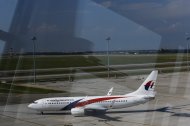Global satellite company Inmarsat's raw tracking data on the missing Malaysia Airlines flight MH370 supports the conclusion that the aircraft had run out of fuel and crashed in the southern Indian Ocean, the New York Times (NYT) reported today.
The raw data shows that the final satellite transmission was an automated request from the aircraft for another so-called electronic handshake.
But NYT quoted a Chinese national, Wang Le, who lost his mother on the plane, as saying that the release of the data was of no help to affected families.
“What help will publicising this data provide toward finding the airplane? This kind of data is too technical for family members, we cannot understand it, and we also don’t know whether it’s real or fake,” he said.
Earlier today, Malaysia's Department of Civil Aviation and Inmarsat finally released the raw data used to determine the path of the missing aircraft, after weeks of pressure from families of the passengers.
The Australian Transport Safety Bureau (ATSB) said the data was consistent with satellite communication equipment on the aircraft failing, adding that interruption in electrical supply in the plane may have been caused by fuel exhaustion.
Quoting Tim Farrar, a satellite communications consultant based in California, the NYT reported that the raw data appeared to support calculations by Inmarsat and by governments involved in the search that the aircraft had crashed into the Indian Ocean.
Farrar said that calculations show that the lost plane turned south after it did a U-turn over the Gulf of Thailand, flew west across Peninsular Malaysia and then disappeared from radar just north of the Indonesian island of Sumatra (see map, bottom).
When officials in Kuala Lumpur, who were involved in the initial search and rescue operations, realised that the plane kept flying for six hours after its communications gear was turned off over the Gulf of Thailand, they suggested two possible arcs for the plane's direction.
The first arc, referred to as the northern corridor, was to the north in Central Asia, while the second was to the south, towards the southern Indian Ocean.
The data released today confirms that small changes in the position of Inmarsat’s satellite relative to the Earth supported the conclusion that the plane flew south, not north, Farrar told NYT.
He also discounted any possibility that the plane flew west-southwest, perhaps to Diego Garcia, a British atoll in the middle of the Indian Ocean where the United States has a large military base.
“That’s clearly not consistent with these arcs,” he told the NYT.
The raw data released today covers transmissions from the aircraft, a series of so-called electronic handshakes, but does not include more sensitive information on how Inmarsat’s ground station in Perth, Australia, receives and records satellite transmissions.
This ensures that intelligence agencies from countries such as North Korea are unable to track flights elsewhere based on the raw data. This is also because various aircraft use different types of satellite transmission terminals on board, the NYT report added.
The satellite signaling, referred to as a handshake, was between the ground station and the plane’s satellite communications system. For each transmission to the aircraft, the ground station recorded a “burst timing offset” and “burst frequency offset”.
The burst timing offset measures the time it takes for a transmission to make a round trip between the ground station, the satellite and the plane and then back. That allowed the authorities to calculate the distance between the satellite and the aircraft.
The burst frequency offset was used to help estimate the aircraft’s speed and direction. This offset measures the difference between the expected frequency of the transmission and the frequency received at the ground station.
Meanwhile, the ATSB said the mapping of the ocean floor, already under way, would take at least three months to complete, in waters that could be as deep as 20,000 feet, the NYT reported.
Once this bathymetric survey has been completed, it could take another year to finish the deep-sea search of the ocean floor for debris from the Boeing 777, the ATSB added.
ATSB chief commissioner Martin Dolan said that the complexities surrounding the search “cannot be underestimated” but that he remained “confident of finding the aircraft”.
According to the NYT, a Chinese survey ship has begun mapping the ocean floor and will be joined by a commercial vessel in June. The specialised deep-sea search for debris on the ocean floor will also see the involvement of private contractors at a later stage.
A statement from the ATSB also noted that the suspected final location of the aircraft happened to intersect a flight corridor from the Cocos Islands to Perth.
The release of the data coincides with Prime Minister Datuk Seri Najib Razak's official visit to China today.
Najib's 6-day trip to China is to commemorate the 40th anniversary of his father, former prime minister Tun Abdul Razak's visit to China, to establish diplomatic ties with the communist nation.
Ties between thw two countries have been strained since the loss of flight 370, with Chinese officials and state news media being critical of Malaysia’s efforts to find the plane. Chinese tourism to Malaysia also dropped by a third in the past two months.
Flight MH370 went missing on March 8 after taking off from the Kuala Lumpur International Airport bound for Beijing. There were 239 passengers and crew on board with more than half of them Chinese nationals. – May 27, 2014.











